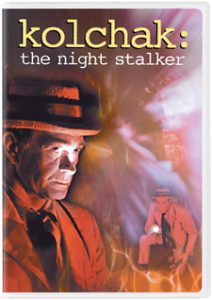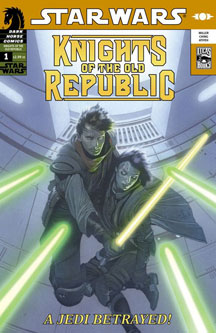“Firefly” — a TV series loosely inspired by “Star Wars” — started and ended in 2002, but it left an impression on the whole sci-fi industry. Dark Horse launched four new “Star Wars” titles a few years later, and three of them – “Knights of the Old Republic,” “Dark Times” and “Legacy” — featured ships with a ragtag crew of noble fugitives. Coincidence? I don’t think so. At least subconsciously, I suspect these series were inspired by “Firefly,” and they also paved the way for the current series “Star Wars Rebels,” which also uses the band-on-the-run structure.
First up chronologically is “Knights of the Old Republic,” the breakthrough series for writer John Jackson Miller, who would also go on to be a respected “Star Wars” novelist. Miller spends the opening arc (“Crossroads,” Issue 0, and “Commencement,” 1-6) introducing us to the thrown-together crew of the Last Resort and their predicaments: Zayne Carrick, a mediocre Padawan who gets framed by his masters for their murder of fellow Padawans; Gryph, a Snivvian (think Snaggletooth) criminal in the secretly big-hearted vein of Watto; Arkanians Jarael (a young warrior woman) and Camper (a scatterbrained old tech genius), who just want to be left alone; and finicky robot Elbee, who possesses video footage showing the masters’ schemes.
Joining our heroes in the second arc (“Flashpoint,” 7, 8 and 10) is the rogue Mandalorian Rohlan Dyre, who wants answers as to why his people are fighting this war against the Republic and Jedi.
When I first picked up this series, I was disappointed that “Knights” – which takes place 30 years after the “Tales of the Jedi” saga – didn’t have the ancient feel of its predecessor. The art (by various contributors) is solid, but it doesn’t have that “Tales” flavor in the costumes, vehicles and architecture. On the other hand, I do like that Coruscant doesn’t appear quite as built up as it will three millennia later.
Another disappointment is the “Minority Report” plot; to see a group of Jedi conniving and scheming against Zayne is disturbing. Although Master Lucien and his cadre of seers frame Zayne because they believe he will turn into the next Sith menace, their evidence is scant, and I don’t sympathize with them for a moment.
But I have to admit the six good guys pop off the page. I especially enjoy the interplay between Zayne and Gryph, rivals on opposite sides of the law who suddenly find themselves partners. And it’s nice to see Zayne and Jarael prove their worth to each other with mutual rescues; could a romance be in the future?
Whereas the Jedi in “Tales of the Jedi” such as Ulic Qel-Droma and Nomi Sunrider operated at the forefront of a galactic conflict between Jedi and Sith, playing out epic arcs, Zayne and his new friends are operating in the underworlds (including that of Coruscant) and dark corners.

At the end of “Commencement,” “Knights’ ” premise is established: Zayne will search for evidence of the actual Sith threat, if any. He also presents a rather brash challenge to his former Masters via hologram message: “I’m going to hunt down each and every one of you. The one that confesses (to the murders and the frame job), lives.”
“Flashpoint” brings into play the Mandalorians – who had been encroaching on Republic space – as they kidnap Jarael, whom they mistake for a Jedi. The Mandalorian mad scientist Demagol is doing experiments to see what makes Jedi tick. This arc is decent thanks to the introduction of Dyre and the fascinating Mando culture where deserters are recaptured and sent to the front lines, where they’ll either fight for the Mandos or die.
But in the next two arcs, “Knights’ ” momentum is unfortunately quelled. “Homecoming” (9) gives the backstory of Lucien. Despite his family’s wealth, he had a rough upbringing because his mother treats him poorly. The issue doesn’t do anything to make me sympathize with Lucien’s murder of Padawans and framing of Zayne. “Reunion” (11-12) is another family story as we meet Zayne’s father, a banker named Arvan. It’s nice to know Zayne has family out there who support him. But the elder Carrick will no doubt become a bargaining chip in future yarns; at least he has the protection of being in the employ of Master Vandar, the Grand Master of this time who happens to be the same unnamed species as Yoda. While Vandar doesn’t flat-out accept Zayne’s claim of innocence, he’s also suspicious of Lucien’s group.
Despite the relative weakness of “Homecoming” and “Reunion,” Miller’s characters have me hooked. I especially want to see Zayne and Rohlan get their answers and vengeance from the established powers that have wronged them. And while “Knights” is initially a less epic yarn than “Tales of the Jedi,” maybe these misfits can somehow reshape the galaxy in their journey. Or at least find their own little slices of freedom between the stars.

